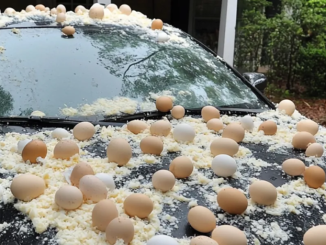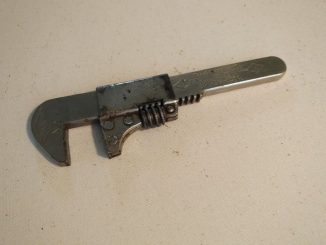
Can a spider poo? A mother turned to Facebook seeking guidance as she expressed her confusion over discovering a set of black droppings scattered throughout her home. Posting on a Mrs. Hinch fan page, she shared a series of images revealing peculiar black specks along her skirting board and wall.

“Anyone have any idea what this is?” She asked. “Just appeared this last week or so on the skirting board in my dining room, also bits on the wallpaper and the floor which gets mopped every day! It’s not bumpy, it looks like some sort of paint splatter but it isn’t.” She continued.

Followers came back with a common answer – Spider Poo

Fellow enthusiasts of Mrs. Hinch promptly came to the rescue, with users confidently asserting that the markings were indeed spider droppings. One wrote: “It happens a lot this time of year, spiders pooing everywhere, Dettox spray is good for it.” While another said: “It’s spider poo after they’ve eaten flies. I get it on my window sill.” Others said it could have been “fly poo” while one user was adamant, it was “spider poo for defs”.
What do the experts say?
According to various sources offering advice on pests, spiders typically do not leave solid droppings; instead, their excrement is thick and liquid in consistency, resembling dark ink stains. These markings often appear on walls and surfaces.
Spider feces are not solid; instead, they appear as dark stains or drips on walls and surfaces. The specific appearance of the droppings varies among spider species, making it challenging for the untrained eye to distinguish.
Typically, spider poop accumulates in a specific location below their web, often in corners with cobwebs on walls. Since spiders seek dark or undisturbed places for refuge, their droppings may unexpectedly appear in various locations. The size of spider droppings is approximately that of a pinhead, and they exhibit a monotone color, with variations in white, black, gray, or brown hues.
Is spider poo dangerous to handle?
While spider poop is not proven to transmit pathogens, it is advisable to treat it with caution and handle it as if it were potentially toxic. Studies indicate that pathogens ingested by spiders do not typically pass on through their droppings.
Nevertheless, it’s important to exercise caution and thoroughly wash hands with soap and water after handling spider feces. Cleaning fresh spider droppings is easier, while dried ones may require more effort to remove and may leave behind yellow stains.
It’s essential to note that cleaning up spider poop does not eliminate the spiders responsible for it. To prevent the reappearance of droppings, taking action against these creatures is necessary. Maintaining a highly tidy environment and removing every spider web you encounter is a good starting point. There are also products available to assist with infestations, and professional pest control services are well-equipped to handle such situations.
Natural Defense Against Colds and Flu

Are you looking for a natural and effective way to improve your health? Look no further! The age-old practice of infusing garlic into milk may be just what you need. This unique elixir has been praised by cultures worldwide for its medicinal properties. Combining the powerful benefits of garlic with the soothing properties of milk, this ancient remedy can address a wide range of health concerns. Let’s explore how incorporating this distinctive blend into your daily routine can elevate your well-being.
Combat Colds and Flu
If you often find yourself battling colds and flu, garlic milk may become your new secret weapon. Garlic contains potent antimicrobial and antiviral properties that can help protect you from these common illnesses. By boiling garlic, its active compound called allicin is amplified, making it even more effective in combating pathogens. Consuming garlic milk regularly can reduce the severity and duration of cold and flu symptoms.
Asthma Relief
For individuals dealing with asthma, finding natural remedies to alleviate symptoms can be a game-changer. Garlic milk is renowned for its ability to provide relief for respiratory conditions like asthma. Garlic’s anti-inflammatory effects can help alleviate airway inflammation, easing symptoms such as wheezing and shortness of breath.
Improve Sleep Quality
If you struggle with insomnia, garlic milk might be a solution worth trying. The combination of milk, which contains sleep-inducing tryptophan, and garlic’s relaxation effects can create an environment conducive to sleep. Drinking garlic milk before bedtime can enhance the quality of your sleep.
Digestive Health
Both garlic and milk have properties that promote healthy digestion. Garlic stimulates the digestive tract, while milk soothes stomach discomfort. Together, they alleviate digestive issues such as bloating and constipation.
Heart Health
Garlic is well-known for its ability to improve heart health by lowering blood pressure and cholesterol levels. Compounds in garlic aid in blood vessel dilation and improved circulation, supporting overall cardiovascular health.
Stronger Bones
Maintaining strong and healthy bones is important, especially as we age. Garlic, when combined with milk, can contribute to bone strength and density. Garlic boosts estrogen levels, which is particularly beneficial for women’s bone health. Milk’s calcium content further enhances the strengthening effects of this combination.
How to Prepare Garlic Milk
To enjoy the benefits of garlic milk, you’ll need a handful of garlic cloves and approximately one cup of milk. Crush the garlic cloves, mix them with the milk, and bring the mixture to a boil. Allow it to cool to a drinkable temperature. For optimal benefits, consume the garlic milk warm, preferably in the evening.
Considerations
Before incorporating garlic milk into your routine, there are a few things to consider. If you have allergies to dairy or garlic, it’s best to avoid this remedy. Additionally, if you have underlying medical conditions or are taking medication, it’s important to consult a healthcare professional before starting this remedy.
In summary, harnessing the healing properties of garlic and milk can provide a potent and natural remedy for various health issues. This simple and cost-effective approach can easily be integrated into your daily routine. While it offers numerous benefits, it’s important to view it as a complementary therapy rather than a standalone solution for serious health conditions.
Remember, as Barbara O’Neill aptly emphasizes, “The synergy between garlic and milk exemplifies the power of traditional remedies in addressing modern health concerns. Integrating natural solutions into our routines can offer multifaceted benefits, promoting overall well-being.”



Leave a Reply